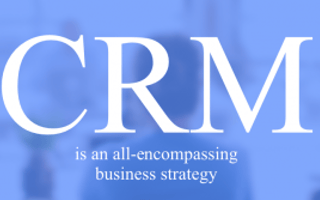This article was originally posted on Synap Software Lab's blog: http://journeys.getsynap.com/

Given the emphasis placed on customer relationships nowadays, it is surprising to me how many of us still miss the boat when it comes to managing them. Most organizations take a narrow approach to relationship management that starts and stops with their CRM software.
I have been using, building, and selling CRM software since the 90’s and believe that despite the innovations we’ve seen in software tools over the last two decades, most CRM implementations do very little to foster meaningful customer relationships. What’s more, of the thousands of implementations I have encountered across a wide variety of organizations and industries, I have found that they fail more often than they succeed. Why is that?
CRM is not just sales enablement and analytics. It is an all-encompassing business strategy that includes many teams and multiple software products.
Speaking of software...
I had coffee with a guy the morning I wrote this who is responsible for managing 50 customer accounts at a company with locations all over the US. He was in the process of putting his 2017 account development plans together so we spent most of our time discussing how he determines goals and objectives for his accounts.
Along the way, I asked him a few questions about how he goes about writing and organizing his account plans. Is it a standard process? Do all of the account execs at his company do it the same way? Do they input and share their plans in a software product? How does the Chief Revenue Officer evaluate one account executive’s plans relative to her peers? How are you keeping tabs on the voice of the customer and applying it to your product development plans? What kinds of reporting do you do across the account management department spread out across the rest of the country?
His answers were like those of many other people I know in account management:
“We track our opportunities in ‘XYZ CRM’ but the rest of the process is a scramble because the software doesn’t really fit our process and vice versa. I also have all kinds of analytics about what my customer has looked at on my website and how deep into our most recent newsletter they read before stopping but I’m not getting much out of that stuff. When I meet with my customers I write notes in Word docs, Excel spreadsheets, email, and my notebook. Some of it makes its way into the CRM but usually only right before a sales meeting or a one-on-one with my manager. We don’t really spend much time using our information to plan ahead. We’re mostly just trying to upsell our customers every time we can based on what our quarterly revenue goals are.”
This is suboptimal for him, his peers, his boss, and most importantly, his customers. The issue stems from the fact that, for most organizations, the objectives behind their CRM software are quite different from the way things actually work in real life, especially in industries where customer-centric thinking and long-term journey mapping is a must.
Qualitative & quantitative measures matter
Sophisticated tools for analyzing customer data have made it possible for companies to target them in subtle ways based on trends and correlations. But as I’ve written before, relying too much on the quantitative aspects of customer relationships can have negative consequences. It is a virtual guarantee that the most important data about my friend’s customer relationships isn’t going to be found in his CRM. It is trapped in his and his co-workers' heads as well as the notebooks, email, and Office documents he was talking about.
My friend is getting all the metrics he can use - and then some - and using correlations to close some follow-on business, but he isn’t really nurturing or developing meaningful and long-lasting relationships with his customers. As a result, he is missing out on the bigger picture and, more likely than not, stepping over dollars for dimes. It’s a classic example of relying too heavily on data alone, which often leads to managing relationships haphazardly.
Clayton Christensen and his colleagues discuss this idea in detail in a September 2016 Harvard Business Review article titled, Know Your Customers’ “Jobs to be Done”. In it, they state that “after decades of watching great companies fail, we’ve come to the conclusion that the focus on correlation—and on knowing more and more about customers—is taking firms in the wrong direction. What they really need to home in on is the progress that the customer is trying to make in a given circumstance—what the customer hopes to accomplish. This is what we’ve come to call the job to be done.”
In this context, “job” is shorthand for what a customer is hoping to accomplish in a particular circumstance. What Mr. Christensen’s experience reminds us is that relationships aren’t numbers and CRM isn’t just a tool for driving efficiency and creating fancy pie charts - although we all love pie charts (and pie)!
Relationships are built on shared experiences, not on data. Data provides us with clues and insights into what to focus on in order to build relationships. Effective relationship management combines the best of both quantitative and qualitative experiences - represented by data - to devise ways to understand not just the behavior of the customer but their deep-seeded needs as well. It is dependent on effective policy, people, and process and it’s ultimate goal is to foster a spirit ofpartnership.
CRM software is an important tool for enabling better relationships to happen, but only when the objectives for its use are clear. To get to clarity, everyone in a company needs to collectively figure out what level of customer relationships are critical to the success of their business and how they can nurture them into becoming part of a trusting community.
Customer relationships are the lifeblood of every company and the tools we use to manage them need to be about more than this month’s sales figures and call reports. When strategically designed and implemented, CRM can be used to measure boththe quantitative and qualitative aspects of customer relationships. And, when CRM really works, it can help you to identify and understand your customers’ “jobs to be done.” Knowing what those jobs are and delivering on them is a sure-fire way tomaximize customer happiness and truly learn how much value your company, products, and people are bringing to your customers.








